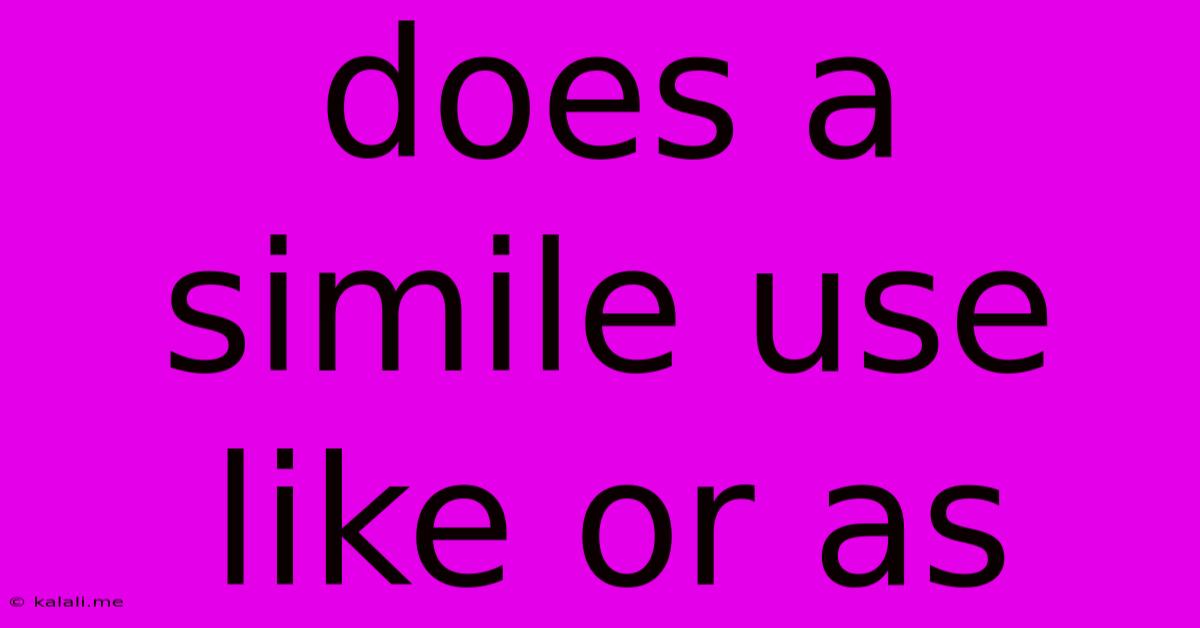Does A Simile Use Like Or As
Kalali
May 23, 2025 · 3 min read

Table of Contents
Does a Simile Use "Like" or "As"? The Definitive Guide
Meta Description: Learn the nuances of similes and understand whether to use "like" or "as" in your writing. This guide clarifies the subtle differences and provides examples for clear and effective simile usage.
Similes are a powerful tool for writers, adding vivid imagery and depth to their prose. They create comparisons between two unlike things, enriching the reader's understanding and experience. But a common question arises: does a simile use "like" or "as"? The short answer is both, but there are subtle differences in their usage that can significantly impact the effectiveness of your simile.
Understanding the Core Function of a Simile
At its heart, a simile draws a comparison, often highlighting a specific characteristic or quality shared by two seemingly disparate things. This comparison is usually signaled by the words "like" or "as." For example:
- "He fought like a lion." This simile compares the man's fighting style to the aggressive behavior of a lion.
- "Her voice was as smooth as silk." This simile emphasizes the texture and pleasant quality of her voice by comparing it to the smoothness of silk.
"Like": The Simpler Choice
Generally, "like" is used to compare nouns, pronouns, or noun phrases. It introduces a simple comparison, often focusing on a single characteristic. Think of it as a more direct and straightforward way to create a simile. Here are some examples:
- He eats like a pig. (Comparing his eating habits to a pig's.)
- She sings like an angel. (Comparing her singing voice to an angel's.)
- The car roared like a monster. (Comparing the car's sound to a monster's roar.)
"As": For More Complex Comparisons
"As" is often preferred for more complex comparisons, particularly those involving clauses or complete phrases. It can be used to describe actions or states of being, offering a more nuanced comparison. Consider these examples:
- As pale as a ghost. (Comparing paleness to the appearance of a ghost.) Note how "as...as" creates a symmetrical structure emphasizing the similarity.
- He ran as fast as the wind. (Comparing speed to the wind's velocity.) This shows a comparison of actions.
- She slept as soundly as a baby. (The comparison involves a state of being – sound sleep.)
When to Use Which: A Practical Guide
While the choice between "like" and "as" often feels intuitive, consider these points:
- Short, direct comparisons: Use "like."
- Comparisons of actions or states of being: Use "as."
- Comparisons needing a more formal or literary tone: "As" often creates a more sophisticated feel.
- "As...as" construction for emphasizing equivalence: This structure usually necessitates using "as."
Ultimately, the best choice depends on the context and the specific nuance you want to convey. Experiment with both to find the option that best suits your writing style and the desired effect.
Avoiding Common Mistakes
- Incorrect use of "like" after a verb of being: Avoid constructions like "She looked like she was tired." Instead, use "She looked as if she was tired." or "She looked as though she was tired." This demonstrates a more grammatically sound comparison.
- Overusing similes: While similes enhance writing, overuse can dilute their impact. Strive for quality over quantity, choosing only the most effective similes to convey your intended meaning.
By understanding these subtle differences and applying them thoughtfully, you can elevate your writing and create more impactful and engaging similes. Remember, practice makes perfect; the more you write, the more naturally you will choose the most suitable word for your comparisons.
Latest Posts
Latest Posts
-
Tf2 How To Remove Time Limit
May 23, 2025
-
Pilot Light Keeps Going Out Furnace
May 23, 2025
-
How To Get Spray Foam Off Hands
May 23, 2025
-
Is Dawn Dishwashing Liquid Safe For Plants
May 23, 2025
-
Can A Jehovah Witness Marry A Christian
May 23, 2025
Related Post
Thank you for visiting our website which covers about Does A Simile Use Like Or As . We hope the information provided has been useful to you. Feel free to contact us if you have any questions or need further assistance. See you next time and don't miss to bookmark.